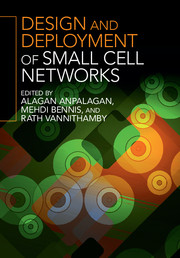Book contents
- Frontmatter
- Contents
- List of contributors
- Preface
- 1 Mobility performance optimization for 3GPP LTE HetNets
- 2 Design and performance analysis of multi-radio small cell networks
- 3 Dynamic TDD small cell management
- 4 3GPP RAN standards for small cells
- 5 Dense networks of small cells
- 6 Traffic offloading scenarios for heterogeneous networks
- 7 Required number of small cell access points in heterogeneous wireless networks
- 8 Small cell deployments: system scenarios, performance, and analysis
- 9 Temporary cognitive small cell networks for rapid and emergency deployments
- 10 Long-term evolution (LTE) and LTE-Advanced activities in small cell networks
- 11 Game theory and learning techniques for self-organization in small cell networks
- 12 Energy efficient strategies with BS sleep mode in green small cell networks
- 13 Mobility management in small cell heterogeneous networks
- 14 The art of deploying small cells: field trial experiments, system design, performance prediction, and deployment feasibility
- 15 Centralized self-optimization of interference management in LTE-A HetNets
- 16 Self-organized ICIC for SCN
- 17 Large-scale deployment and scalability
- 18 Energy efficient heterogeneous networks
- 19 Time- and frequency-domain e-ICIC with single- and multi-flow carrier aggregation in HetNets
- Index
- References
14 - The art of deploying small cells: field trial experiments, system design, performance prediction, and deployment feasibility
Published online by Cambridge University Press: 05 December 2015
- Frontmatter
- Contents
- List of contributors
- Preface
- 1 Mobility performance optimization for 3GPP LTE HetNets
- 2 Design and performance analysis of multi-radio small cell networks
- 3 Dynamic TDD small cell management
- 4 3GPP RAN standards for small cells
- 5 Dense networks of small cells
- 6 Traffic offloading scenarios for heterogeneous networks
- 7 Required number of small cell access points in heterogeneous wireless networks
- 8 Small cell deployments: system scenarios, performance, and analysis
- 9 Temporary cognitive small cell networks for rapid and emergency deployments
- 10 Long-term evolution (LTE) and LTE-Advanced activities in small cell networks
- 11 Game theory and learning techniques for self-organization in small cell networks
- 12 Energy efficient strategies with BS sleep mode in green small cell networks
- 13 Mobility management in small cell heterogeneous networks
- 14 The art of deploying small cells: field trial experiments, system design, performance prediction, and deployment feasibility
- 15 Centralized self-optimization of interference management in LTE-A HetNets
- 16 Self-organized ICIC for SCN
- 17 Large-scale deployment and scalability
- 18 Energy efficient heterogeneous networks
- 19 Time- and frequency-domain e-ICIC with single- and multi-flow carrier aggregation in HetNets
- Index
- References
Summary
We disseminate a set of small cells' field trial experiments conducted at 2.6 GHz and focused on coverage/capacity within multi-floor office buildings. LTE pico cells deployed indoors as well as LTE small cells deployed outdoors are considered. The latter rely on small emission power levels coupled with intelligent ways of generating transmission beams with various directivity levels by means of adaptive antenna arrays. Furthermore, we introduce an analytical three-dimensional (3D) performance prediction framework, which we calibrate and validate against field measurements. The framework provides detailed performance levels at any point of interest within a building; it allows us to determine the minimum number of small cells required to deliver desirable coverage and capacity levels, their most desirable location subject to deployment constraints, transmission power levels, antenna characteristics (beam shapes), and antenna orientation (azimuth, tilt) to serve a targeted geographical area. In addition, we disseminate specialized solutions for LTE small cells’ deployment within hotspot traffic venues, such as stadiums, through design and deployment feasibility analysis.
Introduction
Small cells are low-cost, low-power base stations designed to improve coverage and capacity of wireless networks. By deploying small cells on top and in complement to the traditional macro cellular networks, operators are in a much better position to provide the end users with a more uniform and improved quality of experience (QoE). Small cells’ deployment is subject to service delivery requirements, as well as to the actual constraints specific to the targeted areas. For a good uniformity of service, in populated areas where the presence of buildings is the main reason for significant radio signal attenuation, small cells may need to be closely spaced, e.g., within a couple of hundred meters from each other. Naturally, the performance of small cells is highly dependent on environment-specific characteristics, such as the materials used for building construction, their specific propagation properties, and the surroundings. It is particularly important to have a proper characterization of an environment where small cells are deployed.
This chapter focuses on in-building performance and feasibility of LTE small cells through measurements, taking as reference both outdoor small cell and indoor pico cell deployments. We created scenarios where wireless connectivity within a target building is offered either by small cells located on the exterior of other buildings (small cells with outdoor characteristics) or simply by small cells located within the target building (pico cells with indoor characteristics).
- Type
- Chapter
- Information
- Design and Deployment of Small Cell Networks , pp. 338 - 362Publisher: Cambridge University PressPrint publication year: 2015



